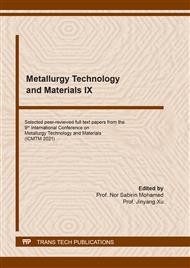[1]
Li L, Xu Y. Development status and trend analysis of lithium ion power battery[J]. China Manganese Industry, 2020, 38(05): 9-13+21.
Google Scholar
[2]
Liu Y, Zhang R, Wang J, et al. Current and future lithium-ion battery manufacturing[J]. Science, 2021, 24(4): 1023-1030.
Google Scholar
[3]
Tian H X, Qin P, et al. A review of the state of health for lithium-ion batteries: Research status and suggestions[J]. Journal of Cleaner Production, 2020, 261(8):120813.1-120813.30.
DOI: 10.1016/j.jclepro.2020.120813
Google Scholar
[4]
Yan H, Zhang D, Qi, et al. A review of spinel lithium titanate (Li4Ti5O12) as electrode material for advanced energy storage devices[J]. Ceramics International, 2021, 47(5): 5870-5895.
DOI: 10.1016/j.ceramint.2020.10.241
Google Scholar
[5]
Yang Y, Okonkwo E G, Huang G, et al. On the sustainability of lithium on battery industry–A review and perspective[J]. Energy Storage Materials, 2021, 36(5): 186-212.
DOI: 10.1016/j.ensm.2020.12.019
Google Scholar
[6]
Yi T F, Wei T T, Li Y, et al. Efforts on enhancing the li-ion diffusion coefficient and electronic conductivity of titanate-based anode materials for advanced Li-ion batteries[J]. Energy Storage Materials, 2020, 26: 165-197.
DOI: 10.1016/j.ensm.2019.12.042
Google Scholar
[7]
Tang Y, Yue F, Guo X Y, et al. The next generation of electrochemical energy storage technology of the international development trend analysis[J]. Energy Storage Science and Technology, 2021, 49(8):1-9.
Google Scholar
[8]
Vikram Babu B, Redd M S, Chandana G, et al. Microstructural, impedance and conductivity studies of magnesium doped lithium titanate materials for li-ion batteries[J]. Materials Today: Proceedings, 2021, 43(47): 1539-1544.
DOI: 10.1016/j.matpr.2020.09.366
Google Scholar
[9]
Ji G, Ma Y, Ding B, et al. Improving the performance of high capacity li-ion anode materials by lithium titanate surface coating[J]. Chemistry of Materials, 2012, 24(17): 3329-3334.
DOI: 10.1021/cm301432w
Google Scholar
[10]
Hu Y.X, Zhao G.J. Application and safety analysis of lithium ion battery in energy storage[J]. Power Supply Technology, 2021, 45(01): 119-122.
Google Scholar
[11]
Li J, Zhu Y, Wang L, et al. Lithium titanate epitaxial coating on spinel lithium manganese oxide surface for improving the performance of lithium storage capability[J]. ACS Applied Materials Interfaces, 2014, 6(21): 18742-18750.
DOI: 10.1021/am504319y
Google Scholar
[12]
Lai Y L, Yang K, Liu H, et al. Review of safety warning methods for lithium ion batteries [J]. Energy Storage Science and Technology, 2020, 9(06): 1926-1932.
Google Scholar
[13]
Yang B, Cui N X, Wang M C. Internal short circuit fault diagnosis for lithium-ion battery based on voltage and temperature[C]. Proceedings of the third Annual Conference of Vehicle Control and Intelligence Committee of Chinese Association of Automation. 2019,28(09): 1-6.
DOI: 10.1109/cvci47823.2019.8951717
Google Scholar
[14]
Muhammad R, Muhammad A. Understanding the low temperature electrochemistry of magnesium-lithium hybrid ion battery in all--phenyl--complex solutions[J]. Journal of Energy Chemistry, 2021, 56(38): 383-390.
DOI: 10.1016/j.jechem.2020.08.018
Google Scholar
[15]
Yang X, Zhan C, Ren X, et al. Nitrogen-doped hollow graphite granule as anode materials for high-performance lithium-ion batteries[J]. Journal of Solid State Chemistry, 2021, 303(09): 453-460.
DOI: 10.1016/j.jssc.2021.122500
Google Scholar
[16]
Zhou Z R, Zhang Y J, Dong P, et al. Research overview of lithium ion battery cathode material[J]. Nonferrous Equipment, 2020(02): 7-11.
Google Scholar
[17]
Luo J, Tian G L, Zhang L L, et al. Review on lithium ion battery system of lithium titanate[J]. Power Supply Technology, 2019, 43(04): 693-695.
Google Scholar
[18]
Zhang Q, Liu Y, Lu H, et al. Ce 3+ -doped Li4Ti5O12 with CeO2 surface modification by a sol-gel method for high-performance lithium-ion batteries[J]. 2016, 189(05): 147-157.
DOI: 10.1016/j.electacta.2015.12.103
Google Scholar
[19]
Feng Y, Wu K, Deng X, et al. Exfoliated graphite nanosheets coating on nano-grained SnO2/Li4Ti5O12 as a high-performance anode material for lithium-ion batteries[J]. Langmuir, 2020, 36(48): 14666-14675.
DOI: 10.1021/acs.langmuir.0c02524
Google Scholar
[20]
Li S, Mao J. The influence of different types of graphene on the lithium titanate anode materials of a lithium ion battery[J]. Journal of Electronic Materials, 2018, 47(9): 5410-5416.
DOI: 10.1007/s11664-018-6439-7
Google Scholar
[21]
Maloney R.P, Kim H.J, Sakamoto J.S. Lithium titanate aerogel for advanced lithium-ion batteries [J]. ACS Appl Mater Interfaces, 2012, 4(5): 2318-2321.
DOI: 10.1021/am3002742
Google Scholar
[22]
Wang J, Ge B, Li H, et al. Challenges and progresses of lithium-metal batteries[J]. Chemical Engineering Journal, 2021, 420(02):746-755.
Google Scholar
[23]
Tan Y, Xue B.Research progress of lithium titanate as anode material for lithium ion battery[J]. Journal of Inorganic Materials. 2018, 33(05): 475-482.
DOI: 10.15541/jim20170330
Google Scholar
[24]
Zhang F, Yi F, Meng T, et al. In situ supramolecular self-assembly assisted synthesis of LTO–carbon-reduced graphene oxide microspheres for lithium-ion batteries[J]. ACS Sustainable Chemistry & Engineering, 2018, 7(1): 916-924.
DOI: 10.1021/acssuschemeng.8b04522
Google Scholar
[25]
Stenina I A, Shaydullin R R, Desyatov A V, et al. Effect of carbon and n-doped carbon nanomaterials on the electrochemical performance of lithium titanate-based composites[J]. Electrochimica Acta, 2020, 364(13):892-899.
DOI: 10.1016/j.electacta.2020.137330
Google Scholar
[26]
Huang F, Ma J, Xia H, et al. Capacity loss mechanism of the LTO microsphere anode of lithium-ion batteries at high temperature and rate cycling conditions[J]. ACS Applied Materials Interfaces, 2019, 11(40): 37357-37364.
DOI: 10.1021/acsami.9b14119
Google Scholar
[27]
Wang Q, Wang H, Wu J, et al. Advanced electrolyte design for stable lithium metal anode: from liquid to solid[J]. Nano Energy, 2021, 80(54):945-954.
DOI: 10.1016/j.nanoen.2020.105516
Google Scholar


